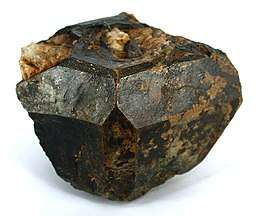Microlite
Microlite was once known as a pale-yellow, reddish-brown, or black isometric mineral composed of sodium calcium tantalum oxide with a small amount of fluorine (Na,Ca)2Ta2O6(O,OH,F). Today it is a name of a group of oxide minerals of a similar stoichiometry having tantalum prevailing over titanium and niobium. The microlite group belongs to a large pyrochlore supergroup that occurs in pegmatites and constitutes an ore of tantalum. It has a Mohs hardness of 5.5 and a variable specific gravity of 4.2 to 6.4. It occurs as disseminated microscopic subtranslucent to opaque octahedral crystals with a refractive index of 2.0 to 2.2. Microlite is also called djalmaite, but both names are now obsolete.
| Microlite | |
|---|---|
 | |
| General | |
| Category | Oxide minerals |
| Formula (repeating unit) | (Na,Ca)2Ta2O6(O,OH,F) |
| Strunz classification | 04.DH.15 |
"Microlite" occurs as a primary mineral in lithium-bearing granite pegmatites, and in miarolitic cavities in granites. Association minerals include: albite, lepidolite, topaz, beryl, tourmaline, spessartine, tantalite and fluorite.
"Microlite" was first described in 1835 for an occurrence on the Island of Uto, State of Stockholm, Sweden. A type locality is the Clark Ledges pegmatite, Chesterfield, Hampshire County, Massachusetts. The name is from Greek mikros for "small" and lithos for "stone."
References
- Palache, C., H. Berman, and C. Frondel (1944) Dana’s system of mineralogy, (7th edition), v. I, 748–757
- Webmineral data
- Mindat with location data
- Mineral data publishing PDF
| Wikimedia Commons has media related to Microlite. |
- Atencio, D., Andrade, M. B., Christy, A. G., Gieré, R., & Kartashov, P. M. (2010). The pyrochlore supergroup of minerals: nomenclature. The Canadian Mineralogist, 48(3), 673-698.doi: 10.3749/canmin.48.3.673
- Andrade, M. B., Atencio, D., Menezes Filho, L. A., & Ellena, J. (2011). The crystal structure of a microlite-group mineral with a formula near NaCaTa2O6F from the Morro Redondo mine, Coronel Murta, Minas Gerais, Brazil (vol 49, pg 615, 2011). CANADIAN MINERALOGIST, 49(5), 1338-1338.doi:10.3749/canmin.49.2.615